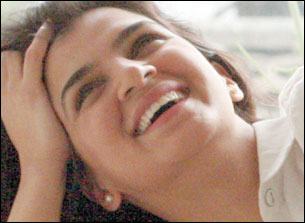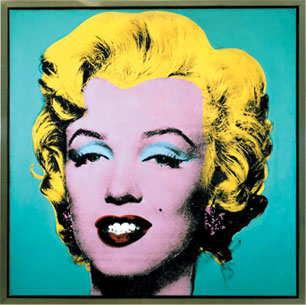|
|
| |
The
Warhol Sixties
By
Aysha Raja
|
| |
 |
| |
Settling
down with a good book has become next to impossible for me. This is
not for the lack of talent, quite the contrary actually; it's just
there's so much out there it's becoming difficult to prioritise.
Sometimes I find myself with five books lined up on my bedside table
all of which I am reading. I guess I got carried away with the Man
Booker long list, and found myself spinning between the acclaimed
titles. Finally this week, I cleared off my bedside table and settled
on Andy Warhol's Popism. It's been at the top of my wish list ever
since its reissue by Penguin UK, and I was happy to forsake the lauded
new writers for a piece of this 20th Century Icon.
I doubt there is a single person who indulges in the contents of Instep
who does not have at least passing knowledge of Andy Warhol and his
work as an artist, but very few people realise he was prolific in
other fields. He was an avant-garde film maker, perhaps the craziest
to have ever picked up a Bolex camera; a music promoter and patron
to the talented Velvet Underground; a writer and diarist; and most
significantly a full- time voyeur.
Popism spans the most transformative decade of the 20th Century. As
the sixties bore witness to a cultural revolution, Andy Warhol charted
his concurrent rise from obscurity in New York. Make no mistake this
is not an art history/ theory book on the Pop movement; it is an out
and out account of the people and ideas Andy encountered during this
unforgettable time. From the vantage point of an insider, or better
still a pioneer of that time, Andy is able to provide us the finest
recollection of that era. |
| |
| Popism
as an art movement can best be described as a realistic depiction
of our modern world, what Andy would describe as “putting the
inside on the outside, and the outside on the inside”. That's
almost all the explanation you will get of Pop Art here, but when
you consider that Andy was responsible for putting Campbell's soup
can on canvas, I guess you can't get more inside or 'domestic' then
that. In many ways Popism, for the purposes of this book, is a wide-eyed
bewilderment of all things new. Whether it was new fashion, new music,
new aesthetics or new values this book celebrates it all with no regard
for the consequences. |
 |
| |
As
a member of the art fraternity in the early sixties, Andy drew some
ire for his 'swish' (as his agent Emile de Antonio once described
it) attitude. Andy held associations with fashion and commercial art,
which no serious artist of that time would allow. He was inexcusably
flamboyant and wore his, and for that matter everybody else's, sexuality
on his sleeve.
After the initial slight, Andy never truly sought the acceptable of
established artists, and his preoccupation was more with people. Misfits,
drug takers, drug pushers, drag queens, penniless thespians, society
ladies and spoilt rich kids populated his petri dish of a studio (The
Factory), and he intently watched them for the scars and bruises of
the sixties. He was not disappointed.
Self destructive behaviour fuelled by the rising use of amphetamines
(commonly used as a diet drug as well as recreationally) was manifesting
itself in the lifestyles of the young and beautiful. Nobody slept;
instead they hurriedly went about having fun, partying, misbehaving
or being creative. Behaviour like dancing on tables lead way to tragic
consequences like the frightening death of a little known dancer Freddy
Herko, who danced his way out of a window. |
| |
Despite
Andy not being a drug taker, many believed he contributed to the demise
of others by standing on the sidelines and doing nothing. Bob Dylan
blamed Andy for Edie Sedgwick's (one time muse of Andy's) increasing
dependency on drugs. Andy defends his position explaining, “I
don't think of myself as evil, just realistic. I learned when I was
little that whenever I got aggressive and tried to tell someone what
to do, nothing happened - I just could not carry it off.....When people
are ready to, they change.”
Popism is strewn with insights into Andy's character without him ever
really writing about himself. There is a wonderful passage where a
regular at The Factory gossips to Andy about what a close aide said
of his nature. This bit of gossip portrays what many might think of
Warhol, but having read this book I now realize this man was a thoughtful
|
 |
|
measured man, free of moral constraints and social conventions. |
Popism recounts Andy's growing fascination with fame. Though baffled
by the hysteria and adoration showered upon him and Edie simply
for turning up at events, Andy's own dalliance with media coverage,
particularly T.V, lead him to coin the oft quoted 'Warhol-ism':
everyone will be famous for 15 minutes.
Andy was nothing less than enthralled by Hollywood. His silk screens
of Liz Taylor, Marilyn Monroe, Elvis, Judy Garland and many, many,
more were testament to his love of stardom. He wanted it for himself
and he loved it in others, even though he clearly saw the shortcomings
and limitations of commercial cinema. The boundaries that Andy wished
to cross through film were impossible to even approach through studios.
He instead became a part of the underground film scene on the west
village of downtown New York, were he was able to indulge his inaccessible
avant-garde impulses with movies like Sleep, which was simply eight
hours of footage of various people he had filmed sleeping.
Popism is filled to the rafters with references to iconic figures
of the Sixties. Andy met them all: Mick Jagger, Jackson Pollack,
Dennis Hopper, Liza Minnelli, David Bailey, Jean Shrimpton, Nureyev.
Andy had high culture covered too: Norman Mailer, Tom Wolfe and
the intellectual Susan Sontag make an appearance in the book. You
could be forgiven for mistaking Popism to be a long drawn exercise
in name dropping, but you would be missing the point. The icons
were a back drop to the lives of the lesser known characters orbiting
Andy: the ones he used in his films, went to poetry recitals with,
hung with at the Factory and partied with.
Popism spans perhaps the most eventful period in Andy's life culminating
with the attempt on his life by the unhinged actress Valerie Solanas.
It is an absorbing 'unputdownable' account of the excesses of the
Sixties and the cultural rebellion that brought us where we are
today. Andy's clarity and detachment allows us to see the era for
what it was, never over intellectualising and always enjoyed the
moment. Popism is book to be savoured, though you may be tempted
to devour it in one sitting.
Aysha Raja is a bookseller and avid consumer of her own wares. She
is the proprietor of a new book service The Last Word.
|
| |
|

